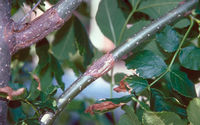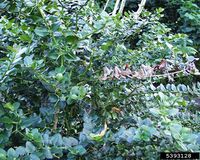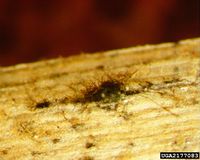Lasiodiplodia theobromae
| Literature database |
|---|
| 288 articles sorted by: |
| • year (descending) |
| • research topics |
| • countries/regions |
| • host plants |
| • list of antagonists |

Author(s): A.J.L. Phillips, A. Alves, J. Abdollahzadeh, B. Slippers, M.J. Wingfield, J.Z. Groenewald and P.W. Crous
Source: Studies in Mycology, 2013, 76, p.75
Lasiodiplodia theobromae (Pat. 1892) Griffon & Maubl. 1909
The fungus has a worldwide distribution in tropical and subtropical regions and causes various dieback, canker, rot and blight diseases, e.g. on avocado (stem-end rot), breadfruit or citrus (Rio Grande Gummosis). It is often regarded as a pathogen of the vascular system which can result in plant death. Stored fruits can be also infected. Spores disperse through the air or by rain splashes and infect plant tissue through small wounds.
The fungus forms dark brown conidia which are thick-walled, egg-shaped to elliptical, have 2 cells when mature and are approximately 25 x 13 µm large. In the sexual stage it forms dark-brown ascomata producing ellyptical ascospores which are about 30-35 x 11-14 µm large.
| Vernacular names | |
|---|---|
| • Deutsch: | Gummose des Zitrus |
| • English: | Java black rot of sweet potato Rio Grande Gummosis dieback of citrus |
| • Español: | chancro de las ramas de los agrios |
| • Français: | chancre des branches des agrumes
pourriture de la cabosse du cacaoyer |
Synonyms:
Botryosphaeria rhodina
Botryodiplodia theobromae
Diplodia gossypina
Diplodia natalensis
Diplodia theobromae
Physalospora rhodina
- Other images of Lasiodiplodia theobromae (IPM Images - click to enlarge)




